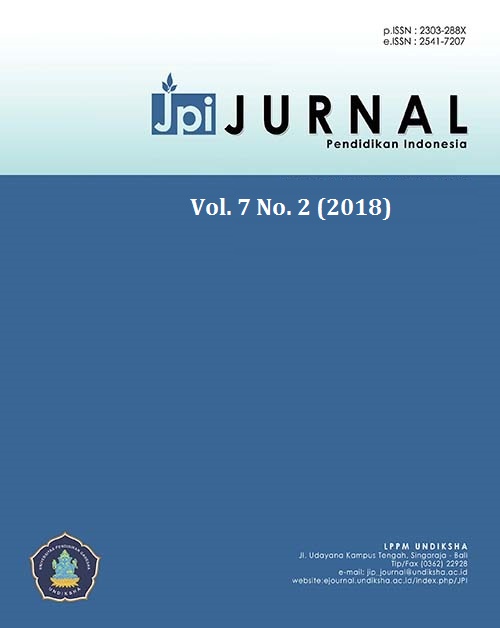THE APPLICATION OF INQUIRY-BASED LEARNING TO IMPROVE STUNDETS’ SPATIAL CAPABILITY IN SMA YPK MEDAN
DOI:
https://doi.org/10.23887/jpi-undiksha.v7i2.11682Kata Kunci:
inquiry, spatial, improvementAbstrak
This study stems from the writer's anxiety about the low ability of spatial students in SMA YPK Medan. The low spatial ability was caused by the ineffectiveness of the learning applied by the teacher. The purpose of this study was to describe the data of students' spatial ability improvement as a result of the application of inquiry learning model. This research was a quasi experimental research with a design used was pretest posttest control group design. The sample of this research were 69 students of SMA YPK Medan. Data to be collected in this research was the data of students' spatial ability. The instrument used to collect the data was a spatial ability test. The data were collected then analyzed by using one-way ANOVA in SPSS program. From result of SPSS obtained data Fcount> Ftable, that is 8,945 > 3,973 and Sig. < , that is 0,04 < 0,05. Based on the results of data analysis could be concluded that the improvement of spatial ability of students who received inquiry learning was higher than the improvement of spatial ability that gets regular learning.
Referensi
Barke & Engide. 2001. Structural Chemistry and Spatial Ability in Different Cultures. Chemistry Education : Research and Practice in Europe. Vol 2.No 3, pp. 227-239.
Beyer, B.K. 1979. Teaching Thinking in Social Studies : Using Inquiry in the Classroom. Columbus, OH : Merril.
Emzir, 2010. Metodologi Penelitian Pendidikan Kuantitatif dan Kualitatif. Jakarta: Rajawali Pers.
Eva, R.F.S & Maya N. 2012. Metode Pembelajaran Inquiry Dan Pengaruhnya Terhadap Hasil Belajar Matematika Ditinjau Dari Kreativitas Belajar. Jurnal Formatif . Vol 2 No 1. pp. 35-44.
Gardner, H & Thomas H. 1989. Multiple Intelligences Go To Scholl: Educational Implications of the Theory of Multiple Intelligences. Educational Researcher. Vol. 18 No 8, pp 4-10.
Hake, R.R. 1998. Interactive-Engagement vs Traditional Methods : A six-Thousand-Student Survey Of Mechanics Test Data For Introductory Physics Course. American Journal of Physics. Vol 66, pp 64-74.
Indriyani, E. 2013. Perbedaan Peningkatan Kemampuan Spasial dan Disposisi Matematis Siswa yang Diberi Pembelajaran Geometri Berbasi Teori Van Hiele dengan dan Tanpa Aplikasi Wingeom di SMP Negeri 4 Binjai. Program Pasca Sarjana Jurusan Pendidikan Matematika Universitas Negeri Medan : Medan.
Kemendikbud.2013.Lampiran Permendiknas No.65 Tahun 2013 Tentang Standar Proses Pendidikan Dasar dan Menengah. Jakarta.
Kusumaningtyas, W. 2016. Efektivitas Metode Inquiry Terhadap Hasil Belajar Matematika Siswa. Jurnal e-DuMath. Volume 2 No 1, pp 102-108.
Maier, P.H. 1998. Spatial geometry and spatial ability-How to make solid geometry solid?. Selected Papers from the Annual Conference of Didactics of Mathematics 1996.
Marliah, S,T. 2006. Hubungan Antara Kemampuan Spasial Dengan Prestasi Belajar Matematika. Makara Sosial Humaniora. Vol 10 No 1, pp 27-32.
NCTM. 2000. Principles and Standars for School Mathematics. Resto, VA: NCTM.
Nemeth, B. 2007. Measurement of The Development of Spatial Ability By Mental Cutting Test. Annales Mathematicae et Informaticae.
Nurhadi, Y.B, & Senduk A.G. 2004. Kontekstual dan Penerapannya dalam KBK . UM Press : Malang.
Russefendi, E.T. 1991. Pengantar Kepada Membantu Guru Mengembangkan Kompetensinya Dalam Pengajaran Matematika Untuk Meningkatkan CBSA. Tarsito: Bandung.
Saragih, S. 2011. Meningkatkan Kemampuan Keruangan Melalui Pembelajaran Matematika Realistik dan Kelompok Kecil Siswa SMP. Disertasi Tidak Diterbitkan. Program Pascasarjana UPI Bandung : Bandung.
Siswanto R.D. & Kusumah Y.S. 2017. Peningkatan Kemampuan Geometri Spasial Siswa SMP Melaui Pembelajaran Inkuiri Terbimbing Berbantuan Geogebra. JPPM. Vol 10 No 1 pp 42-51.
Syahputra, E. 2013. Peningkatan Kemampuan Spasial Siswa Melalui Penerapan Pembelajaran Matematika Realistik. Cakrawala Pendidikan. Th.XXXII No.3, pp 353-364.
Trianto. 2009. Model-Model Pembelajaran Inovatif Beriorientasi Konstruktivistik, Konsep, Landasan Teoritis-Praktis dan Implementasinya. Prestasi Pustaka : Jakarta.
Unduhan
Diterbitkan
Terbitan
Bagian
Lisensi
Authors who publish with the Jurnal Pendidikan Indnesia agree to the following terms:
- Authors retain copyright and grant the journal the right of first publication with the work simultaneously licensed under a Creative Commons Attribution License (CC BY-SA 4.0) that allows others to share the work with an acknowledgment of the work's authorship and initial publication in this journal.
- Authors are able to enter into separate, additional contractual arrangements for the non-exclusive distribution of the journal's published version of the work (e.g., post it to an institutional repository or publish it in a book), with an acknowledgment of its initial publication in this journal.
- Authors are permitted and encouraged to post their work online (e.g., in institutional repositories or on their website) prior to and during the submission process, as it can lead to productive exchanges, as well as earlier and greater citation of published work. (See The Effect of Open Access)








